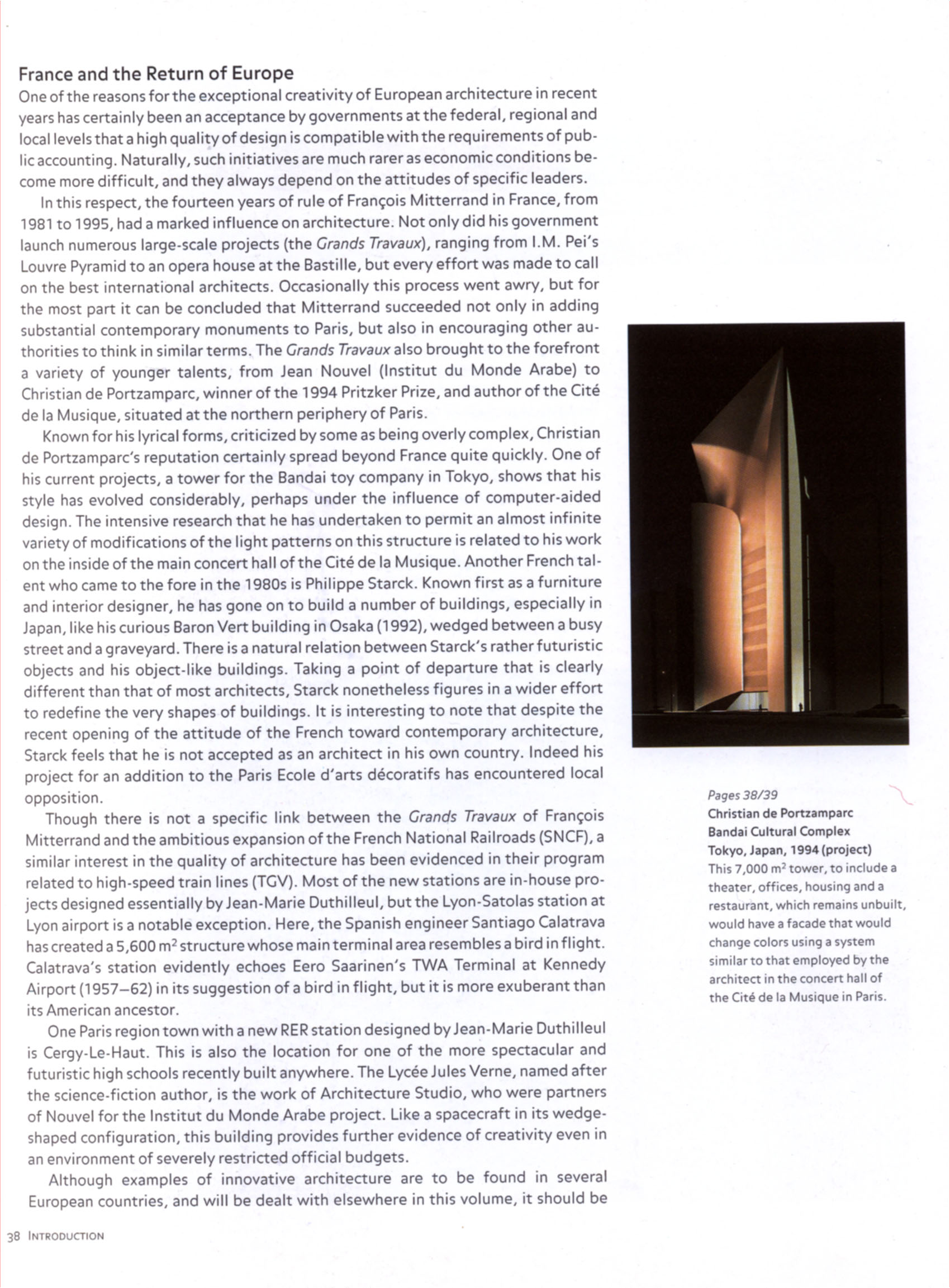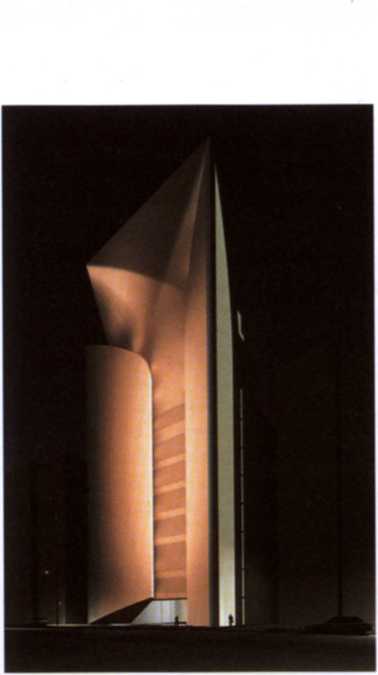14506 New Forms Taschen 035

France and the Return of Europę
One of the reasons for the exceptional creativity of European architecture in recent years has certainly been an acceptance by governments at the federal, regional and local levels that a high quality of design is compatible with the requirements of pub-lic accounting. Naturally, such initiatives are much rarer as economic conditions be-come morę difficult, and they always depend on the attitudes of specific leaders.
In this respect, the fourteen years of rule of Franęois Mitterrand in France, from 1981 to 1995, had a marked influence on architecture. Not only did his government launch numerous large-scale projects (the Crands Travaux), ranging from I.M. Pei's Louvre Pyramid to an opera house at the Bastille, but every effort was madę to cali on the best international architects. Occasionally this process went awry, but for the most part it can be concluded that Mitterrand succeeded not only in adding substantial contemporary monuments to Paris, but also in encouraging other au-thorities to think in similar terms. The Crands Travaux also brought to the forefront a variety of younger talents, from Jean Nouvel (Institut du Monde Arabe) to Christian de Portzamparc, winner of the 1994 Pritzker Prize, and author of the Cite de la Musique, situated at the northern periphery of Paris.
Known for his lyrical forms, criticized by some as being overly complex, Christian de Portzamparc's reputation certainly spread beyond France quite quickly. One of his current projects, a tower for the Bandai toy company in Tokyo, shows that his style has evolved considerably, perhaps under the influence of computer-aided design. The intensive research that he has undertaken to permit an almost infinite variety of modifications of the light patterns on this structure is related to his work on the inside of the main concert hall of the Cite de la Musique. Another French talent who came to the fore in the 1980s is Philippe Starek. Known first as a furniture and interior designer, he has gone on to build a number of buildings, especially in Japan, like his curious Baron Vert building in Osaka (1992), wedged between a busy Street and a graveyard. There is a natural relation between Starck's rather futuristic objects and his object-like buildings. Taking a point of departure that is clearly different than that of most architects, Starek nonetheless figures in a wider effort to redefine the very shapes of buildings. It is interesting to notę that despite the recent opening of the attitude of the French toward contemporary architecture, Starek feels that he is not accepted as an architect in his own country. Indeed his project for an addition to the Paris Ecole d'arts decoratifs has encountered local opposition.
Though there is not a specific link between the Crands Travaux of Franęois Mitterrand and the ambitious expansion of the French National Railroads (SNCF), a similar interest in the quality of architecture has been evidenced in their program related to high-speed train lines (TGV). Most of the new stations are in-house projects designed essentially by Jean-Marie Duthilleul, but the Lyon-Satolas station at Lyon airport is a notable exception. Here, the Spanish engineer Santiago Calatrava has created a 5,600 m2 structure whose main terminal area resembles a bird in f light. Calatrava's station evidently echoes Eero Saarinen's TWA Terminal at Kennedy Airport (1957-62) in its suggestion of a bird in flight, but it is morę exuberant than its American ancestor.
One Paris region town with a new RER station designed by Jean-Marie Duthilleul is Cergy-Le-Haut. This is also the location for one of the morę spectacular and futuristic high schools recently built anywhere. The Lycee Jules Verne, named after the science-fiction author, is the work of Architecture Studio, who were partners of Nouvel for the Institut du Monde Arabe project. Like a spacecraft in its wedge-shaped configuration, this building provides further evidence of creativity even in an environment of severely restricted official budgets.
Although examples of innovative architecture are to be found in several European countries, and will be dealt with elsewhere in this volume, it should be

Pages38/39
Christian de Portzamparc Bandai Cultural Complex Tokyo. Japan, 1994 (project)
This 7,000 m2 tower, to include a theater, offices, housing and a restaurant, which remains unbuilt, would have a facade that would change colors using a system similar to that employed by the architect in the concert hall of the Cit4 de la Musigue in Paris.
38 Introduction
Wyszukiwarka
Podobne podstrony:
76043 New Forms Taschen 051 Britain and Eiffel of France as subcontractors. Another huge Asian proje
45895 New Forms Taschen 019 art and new expressions of the built form. As in art, there may be no do
New Forms Taschen 005 IntroductionNew GeometriesSetting the Scene: From Post-Modernism to Deconstruc
New Forms Taschen 135 Breaking down the Barriers As has already been suggested above in several spec
23706 New Forms Taschen 110 Christian de Portzamparc, author of one of the towers in the Euralilie c
30140 New Forms Taschen 224 ni Collea 40 volumes of TASCHEN S WORLD ARCHITECTURE in eight ycars
New Forms Taschen 091 Fumihiko Maki National Museum of Modern Art Kyoto. Japan, 1983-86 Fumihik
19202 New Forms Taschen 206 exist that are capable of changing from high insulation to Iow, from opa
New Forms Taschen 014 Pages 16/17 Rem Koolhaas Grand Palais Lille, France, 1990-94 Exterio
więcej podobnych podstron